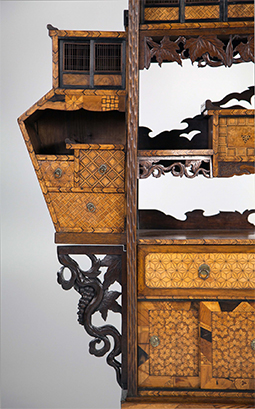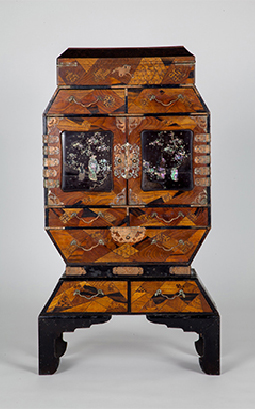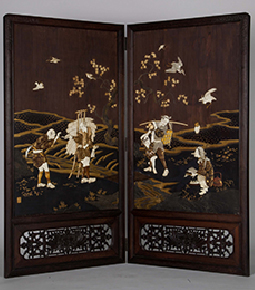 |
Focus features two in-depth reviews each month of fine art, architecture and design exhibitions and events at art museums, galleries and alternative spaces around Japan. The contributors are non-Japanese residents of Japan. |
|
|
 |
 |
 |
Conveying the Spirit of Japanese Craftsmanship: Meiji-Era Furniture Exported Overseas
James Lambiasi |
 |
As the Meiji era (1868-1912) ushered in an unprecedented level of interaction with western society, Japanese crafts were eagerly purchased by foreigners and sent abroad as export items. Not only crafted arts such as ceramics and cloisonne, but furniture made by Japanese artisans also displayed superior workmanship that was well received and consequently exported. While the smaller crafts might have been imported and admired within western homes without any alteration, larger scaled furniture items were sometimes adjusted to suit the functional needs of their new environment. Therefore this surge of Japanese furniture exports not only allowed western households to own and appreciate Japanese crafts, but the commercial necessity to adapt to functional needs spurred alterations in the Japanese designs, thus creating combinations of craft and form that were entirely new to Japan as well.
This phenomenon is explored in depth at the LIXIL Gallery in its current exhibition, Japanese Furniture That Went Overseas - Exquisite Beauty & Delicate Craftsmanship. The show is divided into five different categories of furniture that were produced throughout Japan, each finding its own connection and route to buyers abroad. The presentation of these five types -- Japanese Marquetry, Shibayama Inlay, Inlaid Mother-of-Pearl, Sendai Chests, and Yokohama Sculptural Furniture -- enables viewers to fully comprehend how Japanese furniture captivated western society and gave birth to the common equating of Japanese craft with "exquisite beauty and delicate craftsmanship."
 |
|
 |
|
|
|
|
Detail of Display Cabinet, Hakone, Meiji period, Teruhiko Kaneko collection
|
|
Decorative Chest of Drawers, Shizuoka, Meiji period, Teruhiko Kaneko collection |
In marquetry, a Japanese craft that can be traced back hundreds of years, thin sheets of wood are inlaid to make intricate geometric patterns. Enamored of this delicate detail, foreigners commissioned Japanese artisans to adorn pieces of furniture made to function in a western environment. One example, Display Cabinet, shows the skill of the craftsman in achieving balance in scale, incorporating a broad range of detailing, from intricate to larger scaled, into the item as if it were an encyclopedia designed to highlight the world of Japanese craft. Sliding doors in parts of the cabinet are fashioned to look like sliding shoji panels -- a detail normally not found in the furniture of a Japanese house, and perhaps a light-hearted gesture intended as an explicit reminder of its Japanese origins. A very interesting aspect of furniture for export like this one is that it provides fertile ground for the blending of east and west. For example, while the top part of Decorative Chest of Drawers might be in a familiar proportion for Japan, the addition of legs to lift it off the ground reflects the shift from a tatami floor environment to one of wooden floors and sitting upon chairs.
 |
|
 |
|
|
|
|
Screen - Abundant Harvest, Meiji period, Teruhiko Kaneko collection
|
|
Detail of Screen - Abundant Harvest, Meiji period, Teruhiko Kaneko collection |
Unlike the thin wood inlays of marquetry, Shibayama Inlay gained its reputation for volumetric protrusions of rich materials such as mother-of-pearl, ivory, and coral. The technique acquired its name because it was revived in the late Edo period by an artisan in Shibayama, Chiba. Screen - Abundant Harvest is a hinged screen that showcases the luxuriousness of this craft; it certainly captured the fancy of foreigners, making it a very popular export item. As is evident in its rich combination of different crafts, Shibayama Inlay required masters of such varied skills as inlay, lacquerwork, and carving to work together to produce it. As one examines firsthand this exquisite depiction of gorgeous brocade and carved stones, one can only imagine what a wondrous furniture piece it would have been set with in an 18th-century European household.
Writing Bureau, Nagasaki, Meiji period, Teruhiko Kaneko collection |
Detail of Writing Bureau, Nagasaki, Meiji period, Teruhiko Kaneko collection
|
As intricate mother-of-pearl workmanship evolved over centuries in Japan, it was only natural that functional items such as chests or writing desks would be adorned with this breathtakingly intricate detail. The technique involves polishing shells such as abalone down to such thinness that they are translucent, so that color applied underneath the shell is visible. One fortunate aspect of this technique is that the original color remains well preserved beneath the shell, and retains its vividness. One such exhibit is a Writing Bureau from Nagasaki adorned with a peacock in a pine tree and an abundance of peony flowers. Originally exported to England but now back in Japan, it boasts a front panel that opens to make a writing desk and curving legs at its base that testify to its intended use in a European home. It was most certainly an object of marvel to those who could only dream of making a journey to Japan.
Sendai Chest with a Dressing Table Mirror, circa 1915, Toshi Yunome collection |
Tiger, brassware design for Sendai Chest drawing, personal collection
|
Wooden chests that were crafted during the Edo period (1603-1867) for the samurai class in the Sendai Domain (present-day Miyagi Prefecture) became known as "Sendai Chests." They have three characteristics that exemplify superior craft: finely grained zelkova wood, layering of transparent lacquer, and metalwork depicting ornate dragons and Chinese lions. Because Sendai was visited by foreigners as a summer resort area from the end of the 19th century, these chests became well known and were commonly exported abroad. This phenomenon continued throughout World Wars I and II, as German and American soldiers alike saw the Sendai Chests as both beautiful and functional, thus spurring their popularity overseas. Sendai Chest with a Dressing Table Mirror bears the unique feature of a high-set mirror, most likely less for viewing oneself than for reflecting light in a western room.
As many of these pieces of furniture were originally made to be sent outside of Japan, this show is a great opportunity to see them in their country of origin, as if they had returned to tell tales of their travels abroad. Indeed, the exhibits are arranged ingeniously within a central display that symbolically depicts a ship carrying them across the ocean back to Japan. As examples of some of the first items crafted in Japan to be eagerly purchased for export overseas, one can truly understand the origins of the notion that "Made in Japan" signifies not only the country of origin, but also "exquisite beauty and delicate craftsmanship."
All photos by Naruaki Onishi, shown by permission of LIXIL Gallery. |
 |
 |
James Lambiasi
Following completion of his Master's Degree in Architecture from Harvard University Graduate School of Design in 1995, James Lambiasi has been a practicing architect and educator in Tokyo for over 20 years. He is the principal of his own firm James Lambiasi Architect, has taught as a visiting lecturer at several Tokyo universities, and has lectured extensively on his work. James served as president of the AIA Japan Chapter in 2008 and is currently the director of the AIA Japan lecture series that serves the English-speaking architectural community in Tokyo. He blogs about architecture at tokyo-architect.com.. |
|
 |
|